The magnificent complex of the Metropolitan "Works of the Cathedral" in Siena includes a number of monuments that are among the most significant in Europe. The cathedral undoubtedly represents the fulcrum of the complex, but the Crypt, the Baptistery and the Works Museum are also a significant part of the same large complex that includes both the "Old Cathedral" and the "New Cathedral".
There are numerous sculptures in the Cathedral, which can ben considered all time masterpieces of artistry, seeing they were made by some of the greatest artists: Nicola Pisano sculpted the famous Pergamum or Pulpit, Donatello designed an inte... more
There are numerous sculptures in the Cathedral, which can ben considered all time masterpieces of artistry, seeing they were made by some of the greatest artists: Nicola Pisano sculpted the famous Pergamum or Pulpit, Donatello designed an intense bronze effigy of St. John the Baptist which is kept in the chapel of the same name; Michelangelo made four statues which are inserted in the niches of the Piccolomini Altar; in the Baroque era the plastic arts heritage of the Cathedral was enriched with two statues by Bernini in the Chapel of the Vow, one of the most representative places of worship. In the Piccolomini Library, on the left side of the Cathedral, you can admire the famous frescoes by Pinturicchio which depict the biography of the humanist Enea Silvio Piccolomini, Pope Pius II; the sparkling grotesque vault; the group of marble statues The Three Graces, which is a Roman era copy of the Hellenistic original; the precious 15th century codices put on display in glass cases. Other than the numerous masterpieces from each era, the most exceptional masterpiece of all is the artistic floor, which took 5 centuries to complete, having been created between the fourteenth and the nineteenth century: the artistic floor was created utilizing the opus sectile technique, as the result of a program of classical and religious inspiration. The visit continues to the Crypt, which preserves a cycle of paintings that represent the origins of Italian painting; and to the Baptistery which contains at least one extraordinary work of the early Renaissance, the famous Baptismal Font. The gilded bronze panels, with Stories of St. John the Baptist, were in fact conceived by artists such as Jacopo della Quercia, Lorenzo Ghiberti and Donatello. The evocative decoration of the vaults frescoed by Vecchietta illustrates the articles of the Creed that designate the profession of faith, which was required of a catechumen for admission to Baptism. In the Museum of the "Opera del Duomo", which for over a hundred years has been preserving the precious works of art that come from the Cathedral and which represent a collective memory of historical-artistic, devotional and religious value, it is possible to admire the stained glass window and the large fourteenth-century altarpiece depicting the Maestà by Duccio di Buoninsegna, a masterpiece of medieval European painting; the statues by Giovanni Pisano that decorated the facade of the Cathedral; the Madonna del Perdono by Donatello; and the Golden Rose by Bernini as well as numerous pictorial masterpieces of the Sienese school and an important collection of jewelery and textiles. Going up to into the Façade, we can admire a surprising view of the city of Siena and the boundless surrounding Tuscan countryside. The sixteenth-century Oratory of San Bernardino is also part of the complex, with the cycle of frescoes depicting the story of the virgin. The Diocesan Museum of Sacred Art, located in a few rooms adjoining the Oratory, houses the famous Madonna del Latte by Ambrogio Lorenzetti.
lessBy train: The train takes about an hour and a half from Florence to Siena and runs frequently every day. If you arrive from Pisa you may need to change trains in Empoli. The train from Rome is a little more uncomfortable and not so frequent: you have to change trains in Chiusi. The Siena railway station is located about 1.5 km from the historic city center. The journey is practically all uphill.
By plane: If you arrive at the Florence airport, you can take the shuttle bus (€ 3.10 tickets are on sale from the driver). There is a shuttle bus every hour from Florence Airport, or take a taxi (around € 15) to Florence Central Station (Firenze Santa Maria Novella, Firenze SMN). The shuttle bus (Volainbus) leaves the airport every 30min from 6:00 AM to 8:30 PM, and every hour from 8:30 PM to 11:30 PM, Monday to Sunday. Journey time is 26-28 minutes. The cost of the ticket is € 4.00, tickets are on sale on board.
By car: Getting to Siena by car takes about two hours from Rome and 45 minutes from Florence. Remember that car traffic is strictly limited to circulation outside of the city walls, unless you have a special permit issued by your hotel which allows you to enter the city walls in order to park. The parking lot near the city walls is often full, between locals and tourists seeking to park.
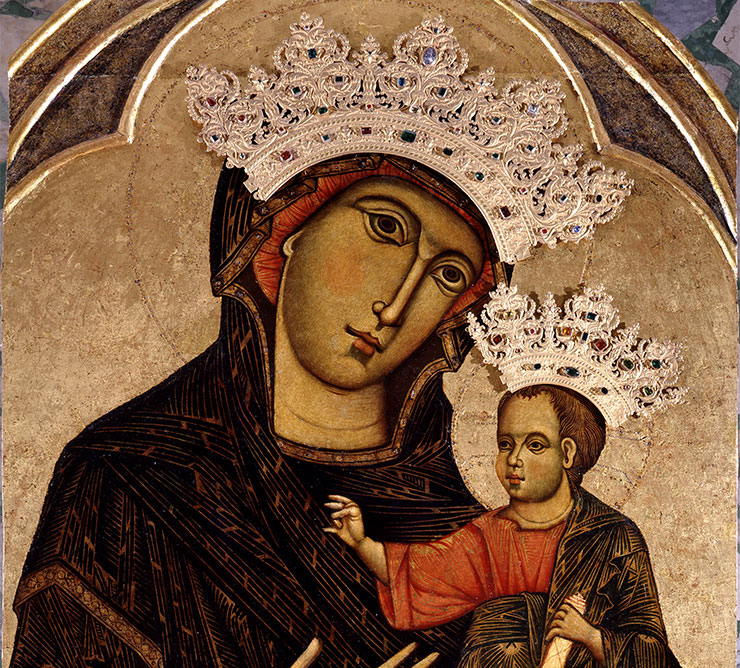
This chapel situated near the beginning of the right transept of the Cathedral, is the most important Marian shrine in the city. It is home to the painting of Our Lady of Graces Advocata Senensium, also known as Our Lady of the Vow, by the painter Dietisalvi di Speme.
In the second half of the seventeenth century, the space was dismantled and the Sienese Pontiff Alexander VII, born Fabio Chigi, decided to have the current chapel built, entrusting the work to the great Baroque artist Gian Lorenzo Bernini.
less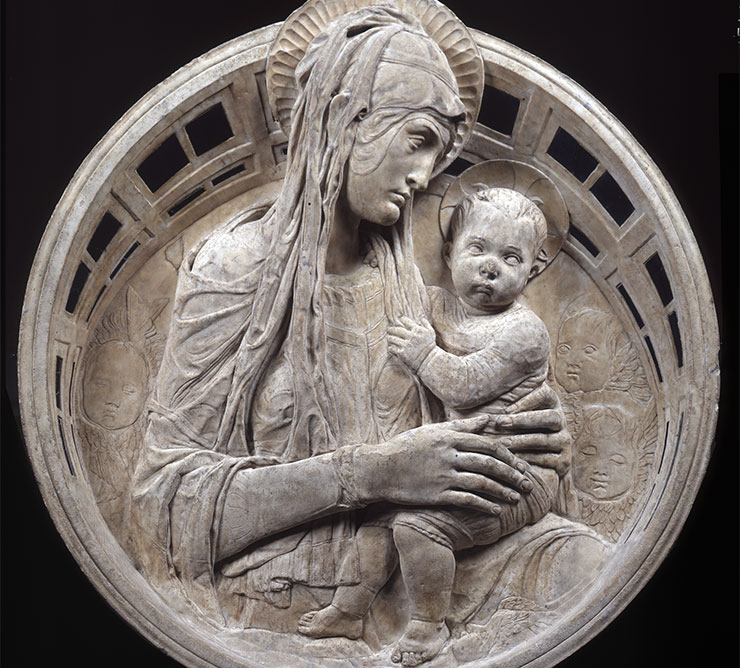
The roundel with Our Lady of Forgiveness is one of the masterpieces that Donatello left in the Cathedral of Siena. The artist, among the greatest protagonists of the early Renaissance, by making use of the 'stiacciato' technique, is able to create a relief that gives an illusion of greater depth.
Our Lady's gaze, with a beautiful, serious and thoughtful face, falls upon the Child as she embraces him with both hands. The work was meant to be seen from below, as evidenced by the extraordinary perspective effect obtained from the strong foreshortening of the figures. Originally it was meant for the Chapel of Our Lady of Graces, located in the right transept of the cathedral.
less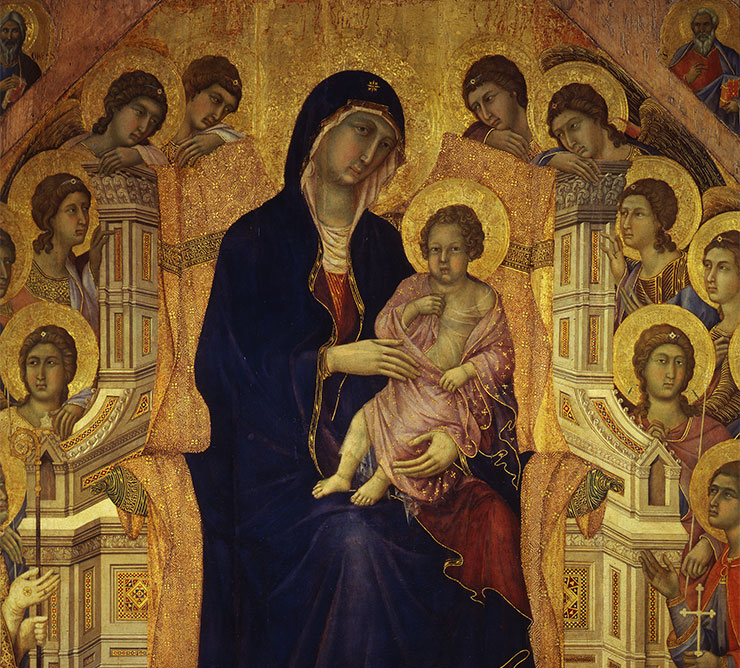
The magnificent altarpiece with Duccio di Buoninsegna's Maestà can be found on the first floor of the Museum, in a nice air-conditioned room. It is an absolute masterpiece of early fourteenth-century Italian painting, and the true charm of the entire collection.
Duccio received the commission for the panel in 1308, and completed it in June 1311. A solemn procession accompanied the piece to its proper place on the main altar of the cathedral. On the front, Our Lady is seated on a throne, and surrounded by a court of angels and saints. She is the perfect image of the mysterious reality of the Church. In fact, like the Church, Mary, though fully human, carries the divine mystery of the Son of God in her womb, to whom she birth and who she offers to those men who seek the path of their destiny. On the back, the Passion of the Christ is told in twenty-six squares. A predella and a crown completed the work and were painted on both sides. The predella, placed below the central panel, contained the Stories of Jesus' infancy on the back, and Episodes from his public ministry on the front. The crown depicted Stories from the Life of Our Lady on the back, and Stories of Our Lord after the resurrection on the front.
less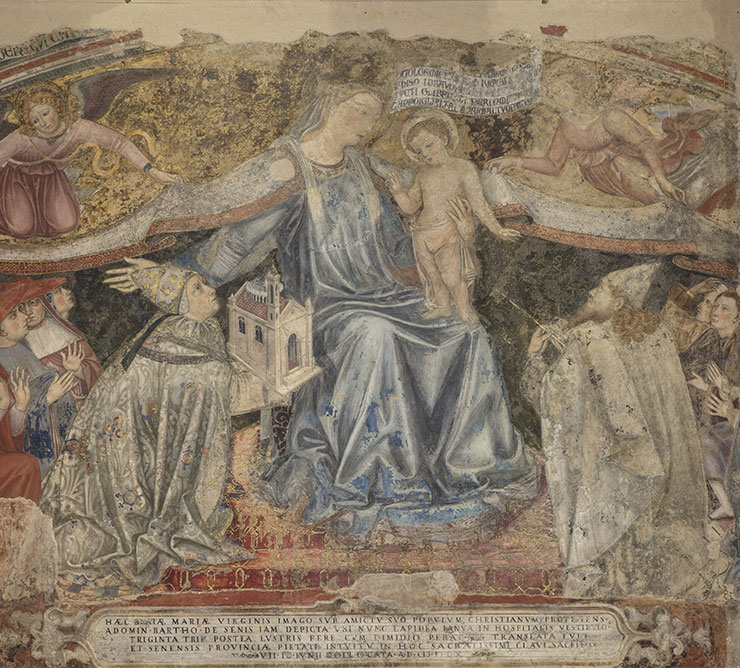
The chapel gets its name from the famous fresco painted by Domenico di Bartolo in 1444, depicting Our Lady of Mercy who welcomes sinners under the protection of her mantle. The chapel had welcomed relics from Santa Maria della Scala in Venice ever since 1359.
The presence of the image of Our Lady in this chapel gave witness to the deep rootedness of the veneration towards Our Lady in this city, so much so that daily forms of devotion took place here. The fresco was removed in 1610 and placed in the Old Sacristy, where all the relics were also transferred, including those of the mantle, veil and waistband of Mary, as well as the most precious relic: that of the sacred nail. The sacristy was completely frescoed in 1449 by Lorenzo di Pietro known as "il Vecchietta" with a cycle dedicated to the Articles of the Apostolic Creed, a subject interpreted by the artist the following year also in the vaults of the Sienese baptistery.
less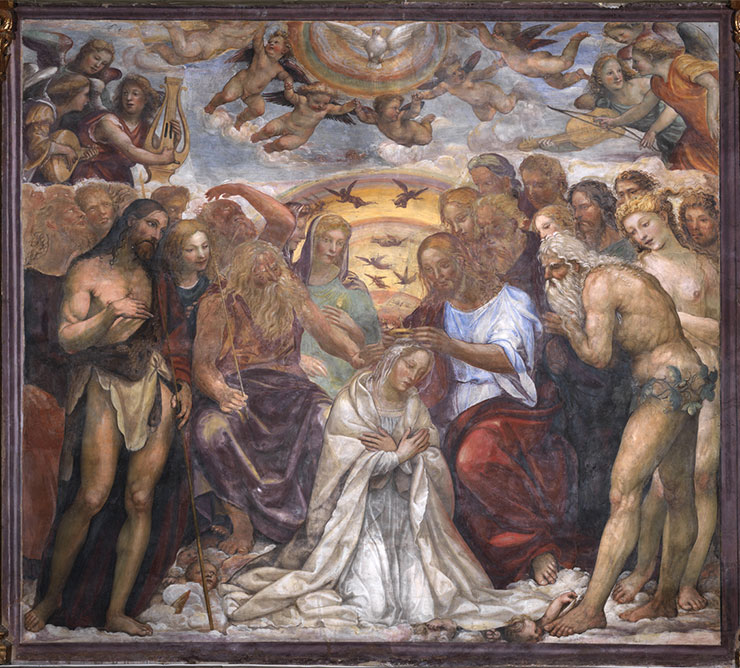
The splendid chapel of the upper oratory dedicated to Saint Mary of the Angels constitutes the heart of the museum. It consists of a single rectangular room with a wooden coffered ceiling depicting golden cherubs on a blue background.
Stories from the life of the Virgin are frescoed along the walls. The scenes are divided by wooden and papier-mâché pilasters decorated with candelabra. Prestigious artists such as Girolamo Pacchia, Giovanni Antonio Bazzi known as Sodoma and Domenico Beccafumi, all active in Siena in the first half of the sixteenth century, contributed to the pictorial decoration of this environment. The iconography aims to celebrate the assumption of Our Lady in body and soul.
less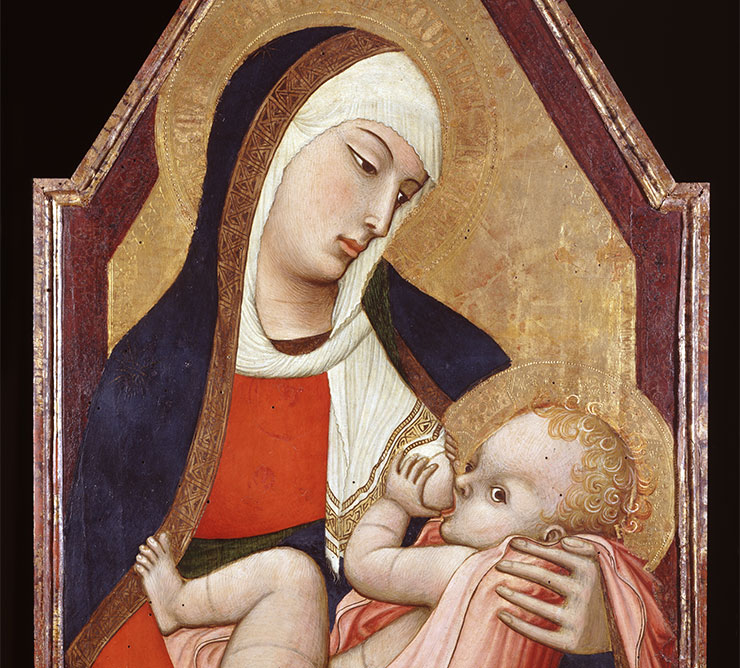
The Nursing Madonna by Ambrogio Lorenzetti is a masterpiece of Italian and European painting of the fourteenth century in regards to the pictorial quality that succeeds in rendering feelings of tenderness. The Virgin Mary has a melanchonic look as she presages the death on the cross of her Son, and she holds close the heavy Child who is the true protagonist of the painting.
While the restless Jesus feeds eagerly on his mother's breast, he seems to look at the spectator with lively eyes. On the nimbus of Our Lady we read AVE MARIA GRATIA PLENA DOMINUS TECUM, the announcement that the Archangel Gabriel brings to Mary as regards the imminent birth of Jesus. The golden background helps to communicate the spiritual and divine reality that the naturalness of the figures might seem to conceal.
less